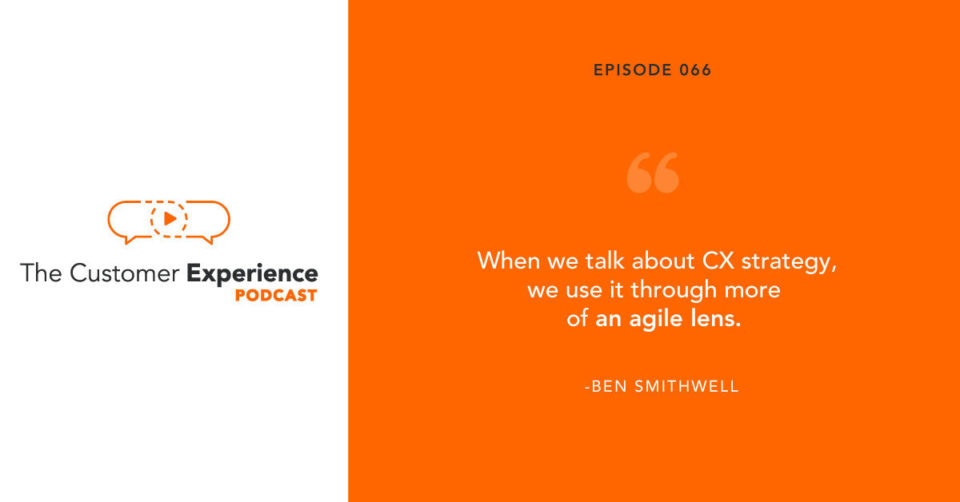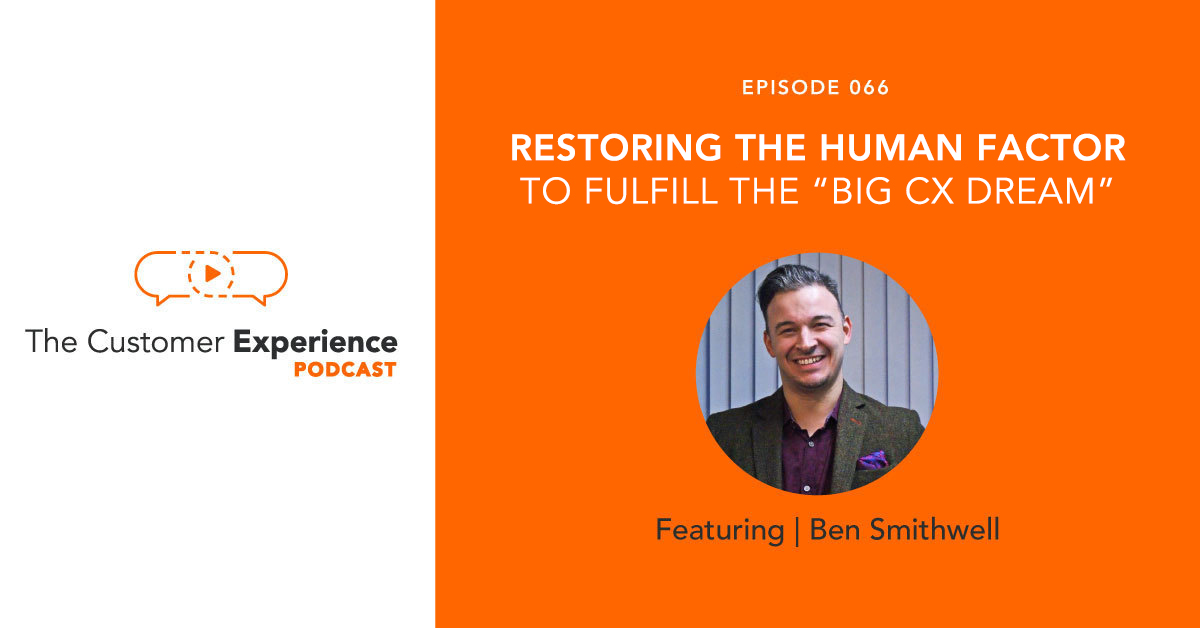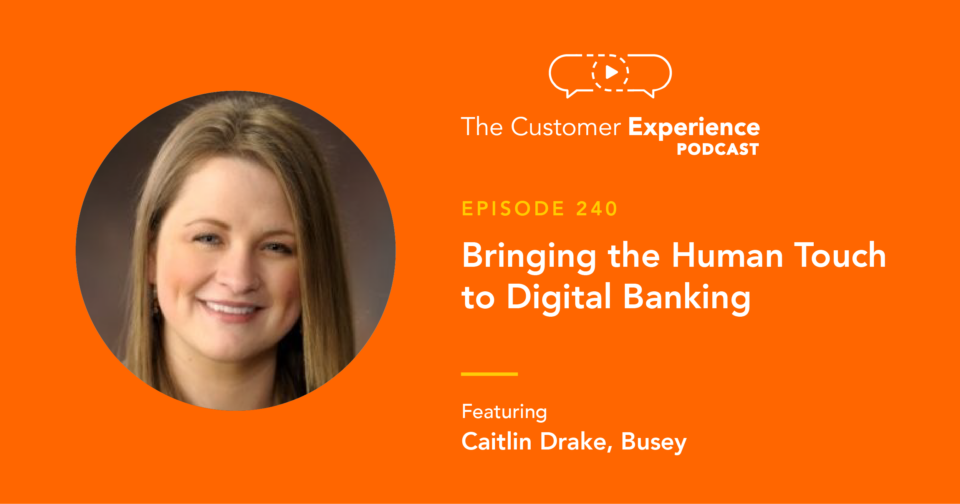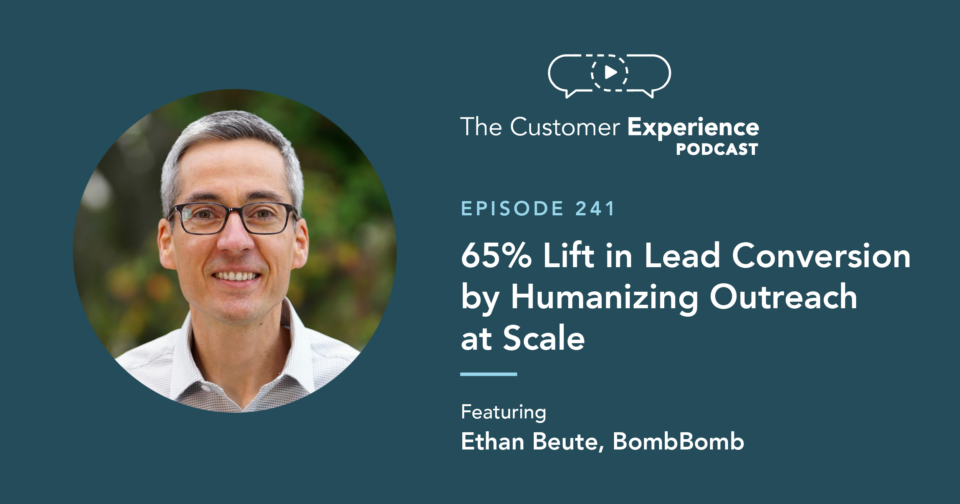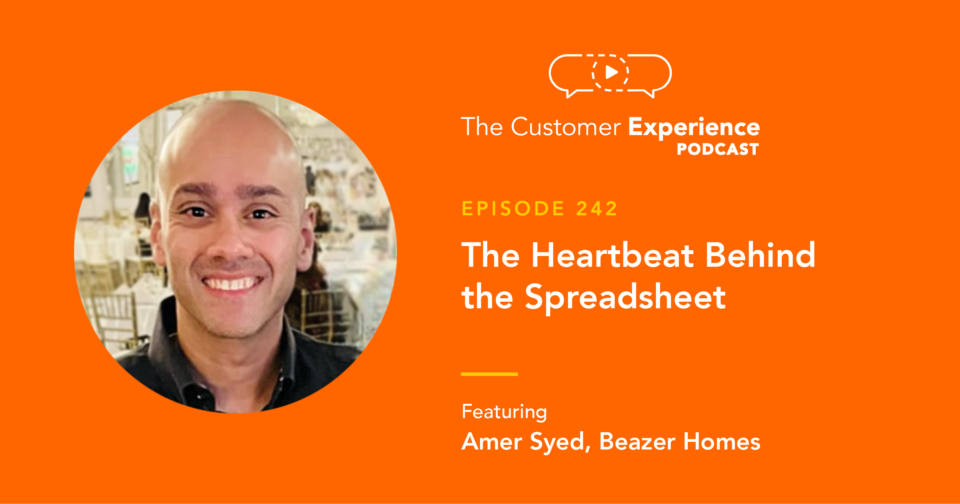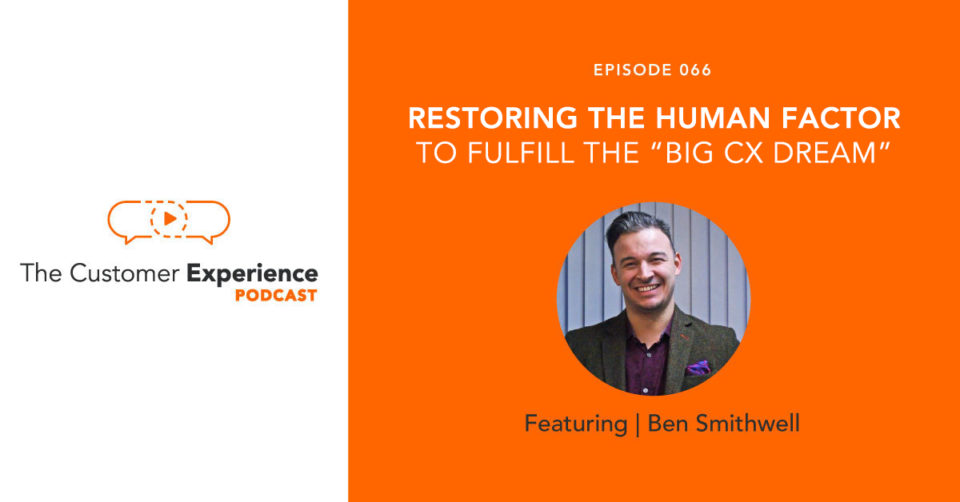
Apple Podcasts | Google Podcasts | Stitcher | Spotify
For all the conversation it’s getting, CX is in a pretty bad state, according to today’s guest. The stagnating macro studies on customer experience like the CXI metric is just one indicator. In other words, the so-called “Big CX Dream” has failed to live up to its billing.
And a reason why so many customer experience programs and initiatives fail to deliver ROI could be that the modern CX movement has all the hallmark characteristics of a belief system.
As an ideology, CX has its origin stories, angels, villains, holy books, acolytes, rules, and unchallengeable axioms of faith. However, some are more true or more helpful than others.
In this episode of The Customer Experience Podcast, we talked about some of the soft spots and even illusions in the modern customer experience movement.
To this conversation about CX as an ideology, our guest, Ben Smithwell, brings expertise he’s been building for years in customer experience and customer success design and strategy.
Ben serves as Director and CX/Service Design Principal at Comotion and the Director and CX/Service Design Strategist at Smithwell.
The one-liner for Comotion: “We build customer-led businesses.”
The one-liner for Smithwell: “Articulating brands through a remarkable experience.”
And after you listen to this episode, check out his TEDx talk about bullying in the workplace (which he delivered half a year apart and 4,400 miles away from mine).
Listen, read, and/or watch this conversation to learn about:
• The Spock vs. Kirk customer experience battle
• The evidence showing how the Big CX Dream has failed to live up to its billing
• The tendency to treat CX as an ideology rather than as a discipline
• The tool-led rather than expertise-driven nature of CX
• The agile methodology‘s application in customer experience
• The human factor‘s promise in fulfilling the Big CX Dream
Hear to the entire conversation with Ben Smithwell right here:
Prefer to take this episode and others with you in your podcast player?
Please subscribe, listen, rate, and review The Customer Experience Podcast here:
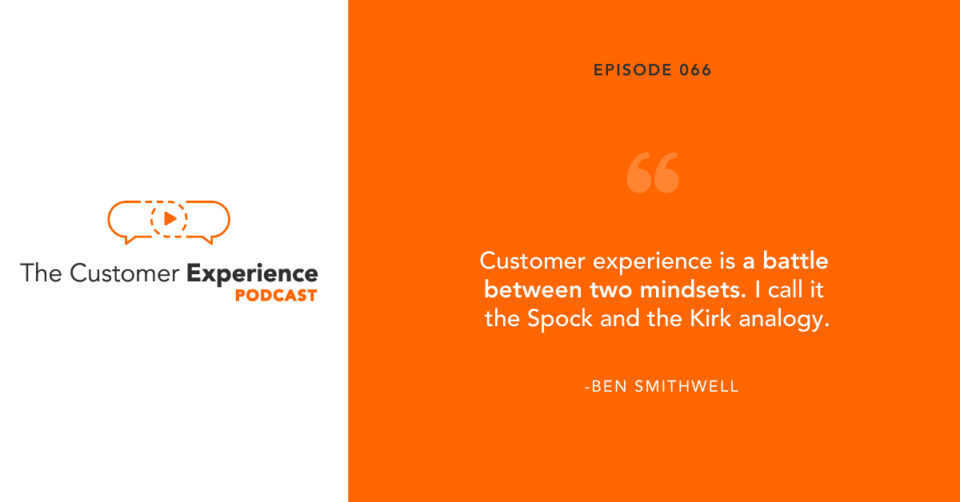
Full Transcript: Restoring the Human Factor to Fulfill the “Big CX Dream”
Ethan Beute:
Today, we’re going to be talking about some of the soft spots and even illusions in the modern customer experience movement. Our guest observes several orthodoxies and rule sets that are in play, and some of them are neither helpful nor effective. To this conversation, he brings an expertise he’s been building for years in CX and CS design and strategy. The one-liner for Comotion, the company he works with, “We build customer led businesses.” The one-liner for Smithwell, his own consultancy, “Articulating brands through remarkable experience.” This one’s going to be fun. Ben Smithwell, welcome to The Customer Experience Podcast.
Ben Smithwell:
Thank you very much for the introduction.
Ethan Beute:
Yeah. Before we get going, you and I have something approximately in common. We both delivered a TEDx Talk at about the same time. Yours was a half a year…
Ben Smithwell:
Oh, right.
Ethan Beute:
Yeah, yeah. Yours was a half a year and 4,400 miles away from mine, and yours, frankly was, I think, more impactful than mine in the way that you delivered it. And it was about bullying as an epidemic in the workplace. People can watch for the details. I’ll drop a link. If you visit bombbomb.com/podcast, I’ll drop a link just like I drop video clips and other elements in around this episode. So people can watch to get the content, but you did a great job drawing a parallel between bullying with your daughter at school and bullying in the workplace, and you had some very specific pauses. You had to walk away from the mic. You created a very powerful experience there. Just talk about that talk, how you prepared for it, especially from an experiential standpoint.
Ben Smithwell:
Yeah, thanks all for that. I’m going to say that is the most terrifying talk I’ve ever had to deliver. As you yourself know, you’ve got your what 10, 11 minutes to do? You’ve got to practice it, you’ve got to know your stuff, it has to be script, you have to know exactly where you are. I think…some of the subject matter was quite emotive, I found it actually very difficult. There was several instances… It’s quite embarrassing actually, where during the talk I nearly just completely lost and had to stop. So I was deep breathing through it. It’s a topic very close to my heart as a consultant going in out of lots of different organizations you can smell the toxicity in some places. You can just sense it a mile off and I think it’s kind of a scandal that no one’s really got their arms around yet. I see it in too many places.
Ethan Beute:
Yeah, it’s really interesting. I do encourage folks to go check it out. Do you remember the title of it, if people wanted to search it? It’s Ben Smithwell TEDx-
Ben Smithwell:
TEDx, Omaha. I think it was called Removing Bullies, or something like that.
Ethan Beute:
Yeah, it is definitely worth a watch because you raised a number of points that are just too far below the radar in the the status quo and the power structure inside most organizations prevents anything from really happening. Until people on the front lines take control over it, and change the culture themselves. So you had a really strong call to action there. Anyway, great work.
Ben Smithwell:
Thank you very much. That means a lot to me. I put a lot of myself into that one, I think. That was a tough talk to do.
Ethan Beute:
So let’s get into it properly. As we get into this conversation and I’m excited to hear your perspective on a variety of things, especially again some of those illusions that we operate under. But let’s start with your thoughts or characteristics of customer experience. When I say customer experience, what does that mean to you?
Ben Smithwell:
That’s a brilliant question because I think the answer is perhaps more difficult than it sounds. If you look at that, the battles become more customer-centric, it feels to me it’s a battle between two mindsets. I call it the Spock and the Kirk analogy. And if you look at I suppose the way businesses are being set up, the very fabric, and structures, and the way we run discipline of labor, et cetera, et cetera, it’s very post-Industrial Revolution. I call it the Spock Orientation where a lot of businesses today are still very driven, for good reasons, by logic, by rigor, by numeracy, by stoicism, by all these good things. Which, are wonderful characteristics. They absolutely need to be there.
Ben Smithwell:
The problem is that starts to feel a little cold, it lacks a little emotion. When the agenda starts to shift from that towards action, we need to double down on providing value for human beings. That orientation becomes less useful. It’s always the interplay between the two. We’re trying to find a balance in the new economy. That’s quite a rambling long answer to your question, but I think that’s fundamentally what we’re talking about there.
Ethan Beute:
I really like the analogy. I like the way you drew it out. I think even as someone who’s not a hardcore Star Trek fan, I could absolutely follow that, and it makes perfect sense. Also, before we go too much farther, can you talk a little bit about who does Comotion serve? Who is your customer? What problem do you solve? And what does a CX strategy and design engagement look like?
Ben Smithwell:
Yeah, sure. So we serve lots and lots of different industries. So we’ve worked within financial services, we’ve worked across public sector as well. We’ve done stints in retail and leisure. I guess if I’m honest, whilst every sector has its own particular problems and problem statements, I think a lot of it all comes down to the same set of problems around how do we continuously provide value to the customer, or the students, or the patient, or the citizen, on an ongoing basis and structure our organization around delivering that consistently? I guess customer centricity, but actually baking it in such that it reorients the DNA of the organization. That’s really what we’re about there.
Ben Smithwell:
So I suppose back to the Spock and the Kirk, the yin and the yang. The second part of your question around your customer experience strategy. We can do all the logic, the rigor, the thinky stuff, the quantity stuff, the numbers, all that stuff. I think where we come into our own is actually on the softer side of things. I think it’s a terrible term for it. It kind of dulls it down.
Ben Smithwell:
We spend a lot of time culturally helping our clients to reorient, to face the fear of change in front of them and these kinds of things. So, if I’m completely honest, I think the best work we do is probably interpersonally. The strategy itself is almost a hygiene factor. To us that’s almost the easy bit. I think helping human beings through a period of change, I think that’s really art, and the science, and the craft of customer experience.
Ethan Beute:
Gosh, I love that you went straight to the human side of it and the behavior change, the perspective change. In a lot of the work that we do here at BombBomb, we’re trying to do the same thing and I see it all the time. I mean transformation and change management, et cetera. Do you have any tips? You seem very oriented toward the human side of things with full and proper respect for the data-driven side and the strategy side. Do you have any tips from working inside a range of different organizations? And I assume a range of personality types. How do you get through to people to help drive that? You know, the change has to come from within. How do you help? I feel like you can’t probably rationalize people into some of the change they need to do, you need to emote them in. Do you have any tips for people that are responsible for changing other people’s perspectives and behavior?
Ben Smithwell:
Yeah, that’s a really good question actually. So I have to answer that in two ways. I think there has to be an emotional side of things and that’s almost an easier one to talk to. And so we’ll do a lot with people around, particularly exec boards around storytelling, trying to help them align I think psychologically and also as a group around a particular vision of the future. Again, without alignment at the top of the organization your things can fall apart very quickly. You can invest a lot of money and just waste it.
Ben Smithwell:
So we double down on that. I think one of my observations around the whole CX space, and I think the customer experiences of profession piece is that some of this rigor is actually missing from all the occasions. It’s as if people have swallowed the human’s pill but forgot about the rigor as well. So a lot of the work, the big corporate is where it fails. Often it does fail unfortunately, is that people haven’t set out right at the beginning of their journey, their transformation journey to prove out the ROI of the experience itself. So for instance, what is the total cumulative value of the leaky bucket at the moment? How much money are we losing from simply being rubbished? How many customers are we turning away? What is the impact… right now today?
Ben Smithwell:
Once you can start to quantify those things out, I think that satisfies the Spock part of the equation for organization. So I think for all the rhetoric around CX as a discipline about human beings, behaviors, and emotions, which okay it is, fundamentally an organization within any sector really only cares about money. A lot of businesses, they care about money. They care about the bottom line. If you do not satisfy the corporates requirement to see things through a financial lens, you’re making money or saving money, you’ve probably lost already. And I think this is what a lot of customer experience professionals are forgetting to do today.
Ben Smithwell:
And I think a lot of the failure endemic in CX transformations is actually one of the simplest I see, is people’s misstep right at the start of the transformative journey into let’s do some great for customers rather than sitting back, saying this is the size of the prize, this is why I need to double down on it yesterday. So I think there’s a miscommunication as in a whole industry.
Ethan Beute:
Even in that answer, I hear the Spock and Kirk, yin and yang in that.
Ben Smithwell:
Right!
Ethan Beute:
And the storytelling, by the way, I mean if you really want to speak to people and connect to people in a meaningful way, that rigor in the beginning to say, what is the harm being done now with the status quo? And what is the potential upside financially if we make the transformation? I mean that’s just part of the story that is going to help people be drawn into the transformation so that they’re bought in, not just cognitively or intellectually, but that they’re also bought in emotionally.
Ben Smithwell:
This is it. What’s in it for you? You know, what do you want to get out of this? How do you want to be famous? We ask people that constantly, how do you want to be famous? What do you want to leave your mark on? I think if you don’t talk to again the rational Spock orientation, the emotional context of say not just the exec, but everyone beneath as well. How do you wrap that into a story? Into a vision that people can buy into. But, also on that personal level what does that mean for your career? It’s almost like a trend for that if you can’t tick all the boxes you’re going to find it very, very difficult to authentically get by.
Ben Smithwell:
I think it’s the thing around authenticity there. I think we would observe a lot of CX efforts are… They’re going off a bit half-cocked. There’s some investment, and they’ll move a few steps forward. And then they’ll stall and then they’ll pile more and more investment, probably not really get the desired ROI, and things will start to really fall through over time. So, you need to keep abreast of the humans all the while.
Ethan Beute:
When you go into these organizations, typically what teams are you working with? And are there stages to this type of… Obviously I’m imagining this, so correct me where my imagination is off. There’s probably some level of a discovery phase where you’re doing some of the quantification you’re talking about and figuring out, you know, who’s who, what’s what, what is the state of affairs? You draw out a plan for the transformation. You probably get buy-in internally from the decision-maker, or your main champions internally, whoever brought you in for the engagement. And then you start executing. Is that the approximate structure and what teams inside an organization are you typically engaging in this transformation?
Ben Smithwell:
Yeah, another great question. So I think transformation can be approached in many, many different ways. Unfortunately, there’s no one size fits all template for it. I would say being consultants are hard. We have 10 million different tools and methodologies, and frameworks, and journeys, you can go through. But, it has to be tailored to the individuals.
Ben Smithwell:
In term of the structure of it, if you’re looking at a CX strategy, I think some of the stages you’ve listed there, they make a lot of sense. I think I suppose the real proof of the pudding is in the eating, and it’s how you respond to things as you go through that journey. It is a journey, and when we speak to our clients we will say there will be blood, snot, sweat, and tears, we guarantee that. And that’s to your alignment thing, how much do you want this? Because this will be difficult.
Ben Smithwell:
But there was usually some kind of a discovery phase, and trying to figure out what the world looks like, what’s shifted in their universe? Has the market shifted? Is something getting disrupted? What is it about the customer? Have they changed? Has their expectations shifted? There’s lots to unpick there, but actually, you’ve hit on something really interesting. I think what the wrong approach would be from experience is to align all of your information, format a problem statement, and then land the big deck on the desk. That absolutely does not work, it’s not very human being centric.
Ben Smithwell:
We find that actually have to review your plans on a much, much more frequent basis to respond to things as they happen. And so when we talk about CX strategy, we actually use it through more of an agile lens I think. You have to have a pretty concrete vision. You have to align around it. You need to have some kind of plan to get there, you need to have just enough wiggle room to change your plans as and when you need to through out that journey. Again, back to the CX as a profession side of things, if you’re not as a function, constantly reorienting around where is the value today? Where is the value tomorrow? Where is the value next quarter? You’ll probably find that your organization will start to lose belief quite quickly.
Ethan Beute:
Yeah, the agile approach makes perfect sense as opposed to dumping a giant plan on and just executing it exactly as designed. I think the agile approach makes so much more sense. You referred to something that I was hoping to talk about a little bit because you’re far more experienced in school than I am by many, many miles or measures, however you want to measure it. You talked about frameworks, or rule sets, or orthodoxies, like different approaches to CX. What are some of those? Where do we get them? How do we judge them? Is there one that you prefer?
Ben Smithwell:
That’s again, a terrific question. I think to answer that, I think I would have to put my stall out early and say I have a problem with a lot of the core orthodoxies of customer experience I think as a profession today. I think the problem to an extent is the orthodoxies, and the degree to which we stick to them. It seems to becoming a very fixed profession with quite a shallow toolkit. I’ll probably come back to that a little bit later.
Ben Smithwell:
For instance, we would observe a lot of customer experience professionals doing a lot of things like journey mapping. That’s absolutely fine, I wouldn’t take that away from anyone. The one thing I would observe, which is one of the central axioms of customer experience management at the moment is that people are doing these things where they’re really questioning, is this going to give us a bad thing?
Ben Smithwell:
Is this the most valuable thing we could be doing right now? There’s no point in spending six months mapping your whole world, doing a load of primary research if fundamentally there’s an obvious problem statement over there somewhere, in let’s say your service centers or a particular part of your digital interactions where you could save several millions of pounds tomorrow. Why would you start with the, I think the output rather than the outcome?
Ben Smithwell:
They’re creating a lot of outputs, but they’re not designing their activity around delivering hard business metric-driven outcomes that businesses fundamentally want from them. So, I think when it comes to the tool kit, I think there’s a lot of stuff that’s been begged, borrowed, and stolen. I can see there’s a lot of stuff from the lean design tool kit there, some stuff from lean, some stuff from agile, a lot of stuff again begged, borrowed, and stolen from the world of service design and design thinking, et cetera, et cetera.
Ben Smithwell:
What I would observe is that the toolkit is getting smaller, and people are embedding deep, and ceasing to think about how could we do things better? I find a lot of the rhetoric within the CX community nowadays is actually quite bland. It’s vanilla, it’s boring. I’ll be honest Ethan, to me, the only sexy thing in CX is talking about how much money you’ve made, how much cost you’ve saved, things like that. That’s what the business cares about. This is a business-oriented discipline.
Ben Smithwell:
I think it’s a secondary observation here around the way that business itself has enveloped CX as a discipline and what it has done with it. Back to this post-Industrial Revolution tailorist mindset. They’re terrified of ambiguity, and as a result, they want certainty. They want stuff to look rigorous, and numerate, and with articles of certainty. They like process, they like to put stuff in little boxes so we can organize it and think the world is less chaotic than it is.
Ben Smithwell:
A group of people who are thought-leaders or experts in an area will start to do some great work, everyone will want in on it. They will start to invest in it heavily, but over time the corporate mentality will take over, and the rhetoric will turn from how can we deliver exceptional value from our customers through to actually, how could we turn this into a five-step process where we start off with this, then we go to that? So the very nature of organizations themselves, it seems to be take the customer experience as a profession will do, and I think empirically is, by the way, get worse over time. It seems the last couple of years, I think things are starting to get worse across lots of different locations in the globe in terms of customer experience, which seems preposterous.
Ben Smithwell:
I’ve seen your sets of longitudinal metrics being measured across in the UK and Europe suggesting the same that customer experiences are probably getting worse. I think that says a lot. I think the profession needs to stand up and probably look at itself in the mirror and think about how it could respond to this.
Ethan Beute:
Can you go deeper on the toolset? You said it’s narrowing, but what are some of the tools and how do those help and or harm the current state of affairs?
Ben Smithwell:
Yeah, that’s a good one. Let me think about the measurement tool kit. That’s a good one to start with. Obviously every organization we speak to is measuring lots and lots of stuff. Again, back to the Spock mentality, you’re trying to wrap your arms around the chaos and ambiguity of the world, so you measure stuff. It’s like a security blanket of numbers. And things like NPS for instance, one of the central tenants and axions of customer experience management that NPS is always kind of Lord of the Rings-esque metrics to rule them all.
Ben Smithwell:
And so everyone adopts it again broadly without thinking about it. They’ll stick it in asking the question in a slight strange way at a slightly different time than is optimum in the customer journey. And then you’ll collect data and you’ll try to extract meaning from it, but it won’t fundamentally get you any closer to understanding, I suppose, the human experience at the end of your company’s product or service.
Ben Smithwell:
So I think one of the central things by now is trying to, I suppose, reeducate people around the fact that it’s great to measure stuff, but that can only tell you so much of the story. I think what I observe at the moment is a lot of professionals are, I think turning CX into, I call it quantitative pornography. You’re going to measure lots of staff, you have your stats, and graphs, and things like that.
Ben Smithwell:
Along with the tool kit, I’d like to see people adopting more deeply would be probably around qualitative research, and the ucky mucky, sleeves rolled up set of activities, and tools, and methods that you can deploy to try and understand people on a deeper, more emotional behavioral level.
Ethan Beute:
So again, here we are at the yin and yang where we do need the hard quant stuff, but we also need the qualitative research, which kind of answers my followup question. If a lot of the basic survey type data, behavior observation that’s highly quantifiable, if those are not enough, where do we get what we need? It sounds like qualitative research. Are there particular approaches to qualitative research that you appreciate more than others?
Ben Smithwell:
It sounds productive, but I think people just need to understand what qualitative research is. I think I’d say probably 90, 95% of CX people I meet, and probably people in business I meet are relatively numerate. They can work their way around stats, and charts, and metrics, and make an interpretation based on that. When it comes to human beings, I think it’s much more difficult. But, I would observe actually if you give people training, which we always do by the way though. Pretty much any clients engagement we have, give people training and basic qualitative research techniques. So, how you would set up hypotheses to test how you would understand what kinds of people you want to speak to and in what manner, and what contextual interview looks like, what ethnography is, and how you can do some basic stuff around that. And then how you can take different ambiguous, wonderful human qualitative sources, overlay some quantitative stuff and try and simulate what that means.
Ben Smithwell:
I think that is one of the core skills that seems to be missing in contemporary business. Again, a lot of people are comfortable with numbers, the human element of things it really, really terrifies people. So I was speaking to a head of science, for a very big multi-billion corporate just last year. He told me unambiguously he didn’t believe in qualitative research, because it was small sample, and therefore it was misleading and a waste of time.
Ben Smithwell:
That actually is quite common I find in business circles. So if there’s one thing I could recommend to people, not just CX people, but I think just business people in general is to acquaint yourselves with the basics, and the fundamentals of qualitative research. It’s probably one of the single most powerful things you could start doing that will tell you, what is happening, your qualitative stuff will help you approximate why something’s happening. And that stuff is absolute gold dust. You can really work with that.
Ethan Beute:
A) I love working with qualitative research, and B) I definitely buy your here’s the what, but then there’s the so what, or even better yet the why so. And qualitative helps build that bridge. But any additional cautions about making sure that… You know, when you’re speaking to an executive like the gentleman you just referred to, how do you walk that down so that there’s that confidence that people need to proceed based on the learning?
Ben Smithwell:
Yeah, that’s a brilliant question. I tried to reframe it just a little bit. If we’re talking about doing insight, and research, and balancing off qual and quant, you’re entirely right, because you could drive a bus through some qualitative research. There will be ambiguity and subjectivity, definitely. If I reframe it as not just insight or research, but also change it to be discussion around insight and design, so rather applied insights. I can change the conversation and say, actually, we will do some qualitative stuff and you are correct because it will absent assumptions, it’ll be mucky, it’ll be greasy, we wouldn’t know what to do with it. But if we view it through a design lens, which is taken inside and do something with it, what we can do is take all of that input and create some hypotheses, and what we’re going to do next, we’re going to test it. On the front line with propositions, with light touch, held together by sticky tape.
Ben Smithwell:
Only when something has had some kind of interface with a customer, do you know whether it’s broadly true or not? And that actually applies to quantitative stuff as well. It’s just the quantitative stuff, it often looks more reliable and it can be statistically and scientifically reliable up front. But if we reframe the conversation around, let’s do something with the insight, let’s test some hypotheses and continue to get closer to the truth, that’s how you can get the value out of these kinds of approaches.
Ben Smithwell:
And so again, what we’re doing there is reorienting for a world where you commission one piece of, I call it, big bang research, and do the one giant quant survey to rule them all, through to what we call minimum viable research, or MVR. Which is where you take a little nibble and you see what you can interpret based on the context and other data points you have. You test it out, perhaps with a different piece of research, but very, very light touch. Sling it at some customers see if it rises or falls. And so, I think you’re taking a much more agile approach to the way you learn about an environment, or a customer’s need. We find that that will bring you closer to the truth over time much, much quicker than if you just rely on one piece of evidence.
Ethan Beute:
So smart. I’m really glad I asked that. And it’s of course completely in line with some of the other themes that you’ve already spoken to, specifically agile. And I love the MVR approach as well. You’re obviously helping a lot of organizations, but you also have a cautionary approach to the big CX dream. CX as an ideology, the corporatization of CX as a discipline. You’ve offered some very fair criticisms as well. What is the next five to 10 years of CX? Where is the best hope? How do we recover from any of the weaknesses that you’ve observed in the way that we’re approaching this today?
Ben Smithwell:
I think at high level we need to create professionals who are comfortable with dealing with ambiguity. And what that mean is that, again, back to your Spock and Kirk orientations. Everything we do is ambiguous. We are selling products and services to human beings. We can never truly know what’s going through their minds. It’s simply impossible. If we run away from ambiguity, that is when CX gets worse. Okay? When we start to run face first into a misty forest, not knowing what’s going to happen, that is when you get the best answers. That’s when you can start to create the best strategies. So, I suppose the analogy of it is if the world is a misty forest I would observe that customer experience specialists are standing around the outside, trying to measure the density of the fog, and perhaps how the trees are, and they’re wondering about what might be in the middle.
Ben Smithwell:
Sometimes the best thing to do is just run into the forest. Which sounds like a bit of a maverick approach, but if I rewind over a couple of decades of work, in this space, that is where you tend to get the best results. You have to hit a problem statement head-on. Almost like the supercollider at CERN see what fractures off it and see what happens. That’s a great way of learning.
Ben Smithwell:
So balance things of chaos and order. That’s like kind of high level stuff. I think at a low level as I mentioned already I want to see people getting much more comfortable with qualitative research and understanding human beings. What would I really aspire for the next five or so years? And this is going to sound really, really unambitious Ethan, but I always try and tell the truth and I think this is what the truth is going to look like. I think we’ll see people hopefully go back to basics. Go back to where this whole thing started and why it works, and why it should work.
Ben Smithwell:
Doubling down on simple things such as can we create the case for change? What does a business case look like? Now I could wax lyrical for probably hours and hours around the different kinds of tools that will be coming our way. And stuff around AI, and ML, and stuff like that. That’s all fine, but these things don’t help until they are in the hands of professionals who know how to use them properly. So, I don’t think there will be any great technological fix. I think all the building blocks are in front of us already, and it’s just about getting back to basics.
Ben Smithwell:
So the first advice I give any new chief custom officer, or head of department, or person wanting to get into CX, particular start of any transformational journey is what are the two, three things to make the biggest impact within the next six months or so? You’ll find a lot of CX departments, if you’re not shown your really strong several X return on the investment within 12 to 18 months, you will start to be sidelined. People become secunded off into different areas of the business. So double down on the impact.
Ben Smithwell:
Everything else can wait, forget your journey maps and your personas and all the pretty stuff you want to stick on the walls. I want to see a selfie in front of a spreadsheet showing how much cash they’ve made for the business, or how much cost they reduced, or how much better empirically they made the experience. So, I think it’s back to basics Ethan.
Ethan Beute:
So good. I like both levels. It’s a great way to kind of put a button on this conversation, which I’ve enjoyed very, very much. If you as a listener have enjoyed this conversation, there are a couple of other conversations here on the Customer Experience Podcast that you might enjoy. Specifically episode 15 with Joey Coleman, another CX designer and strategist. That one is You Have a Hundred Days to Create or Lose a Lifelong Customer. That’s Joey Coleman on episode 15. Or Dan Gingiss on episode 35 Two Keys to Creating Extraordinary Customer Experience, and It’s Easier Than You Might Think.
Ethan Beute:
So Ben, because relationships are our number one core value here at BombBomb and here on the show, I’d love to give you the chance to thank or mention someone who’s had a positive impact on your life or career.
Ben Smithwell:
I think I would say my dad actually. He is an engineer by trade, he had nothing to do with what I do as a profession. He still has no idea what I do. But he was the leader of a company. So way back in the ’80s and they went through a very difficult period. It was the recession, and things were very, very tough.
Ben Smithwell:
I remember the thing I learned from him is to treat people well. I think irrespective of the personal conduct consequences. And so what I observed in him was that they put the employee first and the customer first and nobody lost a single penny that shouldn’t have. So whilst it was a really bad situation all around, I think it was dealt with with humility and truth. And I think I’ve always sort of taken that with me. So I think doing the right thing, I suppose you can’t underestimate the power of that.
Ethan Beute:
Really good, I love this idea of doing the right thing and treating people well regardless of the consequences to yourself. Doing it in the right spirit is almost as important as just doing it. So great reference there. You’re one of only a handful of folks who has mentioned a family member, so I really appreciate that as well. How about a company that you respect for the way they deliver for you as a customer?
Ben Smithwell:
Yeah, this is one of my favorites at the moment. It’s probably not one a lot of CX guys would cite, which I probably quite like about that. I’d say it’s Aldi. Now, you might have heard of them, they’re an enormous supermarket chain. They’re very big in Germany and Europe. About 15, 16% market share in the UK. So they’re a pretty big deal. The interesting thing with Aldi is that if you walk in there, there is absolutely nothing sexy about it at all Ethan, it’s a mess. You’ll probably have pallets on the floor, there will be half empty boxes everywhere. It’s an absolute mess. It’s a bit of jumble sale. But, and this is why I love them, it’s a CX exemplar, they know exactly why their customers go there. And that’s why they don’t pay for extra staff to clean up the floor.
Ben Smithwell:
It’s actually too intense. It’s quite a rubbish experience until you get to the till. The people fire the stuff through the till so quick you can’t actually pack your bags. So the experience in Aldi is you have to bundle stuff into your trolley at warp speed, then you have to take it outside and pack your bags. So, it’s… But, and this is a big but, when you come to pay, you see the figures come up on the screen, you’ll walk out of Aldi, I’ll guarantee, clicking your heels. You’ve absolutely made a wonderful purchase, because they sell stuff that is so cheap, and such good quality, it’s an absolute no brainer there.
Ben Smithwell:
They could tidy up the stores, they could have proper shelves, and get the guys in store to wear the proper uniform all the time, and really make it look great. But actually that will have an impact on the prices, and that’s not what Aldi is about. So they know who they are, they know who that customer is, they play to that high equation, absolutely beautifully.
Ethan Beute:
Fantastic example. We all have to play our own game. We have to know who our customer is. We want to optimize the value equation for them, or even maximize it for them. And so I love this idea of we’re not going to conform to all of the norms and standards that we’re, I’m air quoting here, “supposed to” follow and “supposed to” honor. We’re going to play our game for our customer, and our customers appreciate us for it. So good, great example.
Ethan Beute:
Hey Ben, if people enjoy this conversation, they want to follow up with you or a Comotion, where would you send people to learn more and to connect with you?
Ben Smithwell:
Well, the easiest way is just find me on LinkedIn. I’m on there all the time, so Ben Smithwell. Or could visit our website which is www.comotional.com, so C-O-M-O-T-I-O-N-A-L.com. I’ll be hanging out on one of those two places. I’m very active on LinkedIn, so come and say hi to me.
Ethan Beute:
Reach out to Ben on LinkedIn. Be sure to add a note. I always appreciate when someone adds a note to a connection request for me. It just gives me some context. And if you’re listening to this, you enjoyed it, you want to learn more, you want to check out that TEDx Talk, we put up posts on all these episodes at bombbomb.com/podcast.
Ethan Beute:
Ben, thank you so much for your time. I really, really appreciate everything you brought here.
Ben Smithwell:
Yeah, and thank you so much for your time, this has been wonderful. I’ve really enjoyed this, it’s a real privilege to have joined, so thank you very much indeed.
Video Highlights: Restoring the Human Factor to Fulfill the “Big CX Dream”
Check out two video highlights from the discussion with Ben below…
1. CX, Spock, and Kirk
2. TEDx Talks
Related Links:
- Ben Smithwell on LinkedIn
- Comotion CX Consulting
- Ben’s TEDx Talk “Removing Bullies“
- Ethan’s TEDx Talk “The Flight Back to the Face“
Other CX Conversations You’ll Enjoy:
- “You Have 100 Days To Create or Lose a Lifelong Customer” with Joey Coleman (Chief Experience Composer, Design Symphony)
- “2 Keys To Creating ‘Extraordinary’ Customer Experience” with Dan Gingiss (Chief Experience Officer, Winning Customer Experience)
- “Creating An Amazing Customer Experience By Being ‘Slightly Better Than Average‘” with Shep Hyken (Chief Amazement Officer, Shepard Presentations)
Please Subscribe to and Rate The Customer Experience Podcast:
